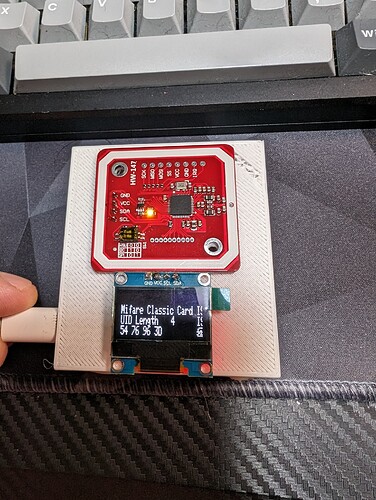Im working my way through a couple small projects and i wanted to release what i had to the community.
I made a small compact reader that can output the UID of 4 and 7 byte Mifare and ISO14443A cards.
Hardware
Arduino Nano or Uno
PN532
SSD1306 OLED 128x32/64 it doesnt matter it gets all fucky in the code.
Pinout
PN532&SSD1306 => Arduino Nano
GND => GND
VIN => 5v
SDA/SCK => A4
SCL => A5
Attached is my code for the Nano, but will also work on the Uno.
I had to reduce the usable size of the screen to fit it into the buffer. If anyone knows how to save the full pixelcount of the screen but still reduce buffer size i am all ears.
#include <Wire.h>
#include <PN532_I2C.h>
#include <PN532.h>
#include <Arduino_GFX.h>
#include <Adafruit_SSD1306.h>
#define SCREEN_WIDTH 128
#define SCREEN_HEIGHT 23
#define OLED_RESET 4
#define SCREEN_ADDRESS 0X3C
PN532_I2C pn532i2c(Wire);
PN532 nfc(pn532i2c);
Adafruit_SSD1306 display(SCREEN_WIDTH, SCREEN_HEIGHT, &Wire, OLED_RESET);
void setup(void)
{
Serial.begin(115200);
while (!Serial) delay(10);
Serial.println("Hello Cyborg!");
nfc.begin();
if (!display.begin(SSD1306_SWITCHCAPVCC, SCREEN_ADDRESS))
{
Serial.println(F("SSD1306 allocation failed"));
for (;;); //Dont Proceed, Loop Forever
}
uint32_t versiondata = nfc.getFirmwareVersion();
if (! versiondata)
{
Serial.print("Didn't find PN53x board");
while (1); // halt
}
// Got ok data, print it out!
Serial.print("Found chip PN5");
Serial.println((versiondata>>24) & 0xFF, HEX);
Serial.print("Firmware ver. ");
Serial.print((versiondata>>16) & 0xFF, DEC);
Serial.print('.');
Serial.println((versiondata>>8) & 0xFF, DEC);
display.clearDisplay();
display.setCursor(0,0); //oled display
display.setTextSize(1);
display.setTextColor(WHITE);
display.print("Found Reader PN532");
display.print((versiondata >> 24) & 0xFF, HEX);
display.setCursor(0,8); //oled Display
display.setTextSize(1);
display.setTextColor(WHITE);
display.print("Firmware ver. ");
display.print((versiondata >> 16) & 0xFF, DEC);
display.print(".");
display.print((versiondata >> 8) & 0xFF, DEC);
nfc.setPassiveActivationRetries (0xFF);
// configure board to read RFID tags
nfc.SAMConfig();
Serial.println("Waiting for an ISO14443A Card ...");
display.setCursor(0, 16); //oled display
display.setTextSize(1);
display.setTextColor(WHITE);
display.print("Waiting for NFC Card");
display.display();
}
void loop(void) {
uint8_t success;
uint8_t uid[] = { 0, 0, 0, 0, 0, 0, 0 }; // Buffer to store the returned UID
uint8_t uidLength; // Length of the UID (4 or 7 bytes depending on ISO14443A card type)
// Wait for an ISO14443A type cards (Mifare, etc.). When one is found
// 'uid' will be populated with the UID, and uidLength will indicate
// if the uid is 4 bytes (Mifare Classic) or 7 bytes (Mifare Ultralight)
success = nfc.readPassiveTargetID(PN532_MIFARE_ISO14443A, uid, &uidLength);
if (success) {
// Display some basic information about the card
display.clearDisplay();
Serial.println("Found an ISO14443A card");
display.setCursor(0, 0); //oled display
display.setTextSize(1);
display.setTextColor(WHITE);
display.print("ISO14443A Bytes: ");
Serial.print(" UID Length: ");
Serial.print(uidLength, DEC);
Serial.println(" bytes");
//display.setCursor(0, 8); //oled Display
//display.setTextSize(1);
//display.setTextColor(WHITE);
//display.print("UID Length:");
display.setCursor(100, 0); //oled Display
display.print(uidLength, DEC);
Serial.print(" UID Value: ");
nfc.PrintHex(uid, uidLength);
//Serial.println("");
//display.setCursor(0, 8); //oled display
//for (int i = 0; i < uidLength; i++)
//{
// display.print("");
// display.print(uid[i], HEX);
// display.print("");
// };
display.display();
if (uidLength == 4)
{
// We probably have a Mifare Classic card ...
Serial.println("Seems to be a Mifare Classic card (4 byte UID)");
// Now we need to try to authenticate it for read/write access
// Try with the factory default KeyA: 0xFF 0xFF 0xFF 0xFF 0xFF 0xFF
display.clearDisplay();
display.setCursor(0, 0); //oled display
display.setTextSize(1);
display.setTextColor(WHITE);
display.print("Mifare Classic Card");
display.setCursor(0, 8); //oled Display
display.setTextSize(1);
display.setTextColor(WHITE);
display.print("UID Length:");
display.setCursor(80, 8); //oled Display
display.print(uidLength, DEC);
display.setCursor(0, 16); //oled display
for (int i = 0; i < uidLength; i++)
{
display.print("");
display.print(uid[i], HEX);
display.print(" ");
}
display.display();
Serial.println("Trying to authenticate block 4 with default KEYA value");
uint8_t keya[6] = { 0xFF, 0xFF, 0xFF, 0xFF, 0xFF, 0xFF };
// Start with block 4 (the first block of sector 1) since sector 0
// contains the manufacturer data and it's probably better just
// to leave it alone unless you know what you're doing
success = nfc.mifareclassic_AuthenticateBlock(uid, uidLength, 4, 0, keya);
if (success)
{
Serial.println("Sector 1 (Blocks 4..7) has been authenticated");
uint8_t data[16];
// If you want to write something to block 4 to test with, uncomment
// the following line and this text should be read back in a minute
// data = { 'a', 'd', 'a', 'f', 'r', 'u', 'i', 't', '.', 'c', 'o', 'm', 0, 0, 0, 0};
// success = nfc.mifareclassic_WriteDataBlock (4, data);
// Try to read the contents of block 4
success = nfc.mifareclassic_ReadDataBlock(4, data);
if (success)
{
// Data seems to have been read ... spit it out
Serial.println("Reading Block 4:");
nfc.PrintHexChar(data, 16);
Serial.println("");
//display.print("Success! Block 4: ");
//display.println("");
//display.display();
// Wait a bit before reading the card again
delay(1000);
}
else
{
Serial.println("Ooops ... unable to read the requested block. Try another key?");
display.clearDisplay();
display.setCursor(0, 0);
display.print("Unable to Read");
display.setCursor(0, 10);
display.print("Whoops");
display.display();
}
}
else
{
Serial.println("Ooops ... authentication failed: Try another key?");
display.clearDisplay();
display.setCursor(0, 0);
display.print("Unable to Read");
display.setCursor(0, 10);
display.print("Whoops");
display.display();
}
}
if (uidLength == 7)
{
// We probably have a Mifare Ultralight card ...
Serial.println("Seems to be a Mifare Ultralight tag (7 byte UID)");
display.setCursor(0, 8);
display.print("Mifare Ultralight");
display.display();
// Try to read the first general-purpose user page (#4)
Serial.println("Reading page 4");
uint8_t data[32];
success = nfc.mifareultralight_ReadPage (4, data);
if (success)
{
// Data seems to have been read ... spit it out
nfc.PrintHexChar(data, 4);
Serial.println("");
display.setCursor(0, 16);
//display.print("");
//display.println("Card UID:");
for (int i = 0; i < uidLength; i++)
{
display.print("");
display.print(uid[i], HEX);
display.print(" ");
}
display.display();
// Wait a bit before reading the card again
delay(1000);
}
else
{
Serial.println("Ooops ... unable to read the requested page!?");
display.clearDisplay();
display.setCursor(0, 0);
display.print("Unable to Read");
display.setCursor(0, 10);
display.print("Something fucked up");
display.display();
}
}
}
}
Reads implants really well, will kick out the UID and tell you the 3 types its capable of.
Quick project if you have the parts laying around.
